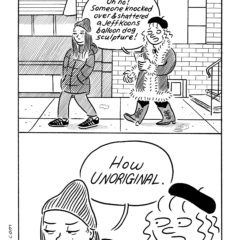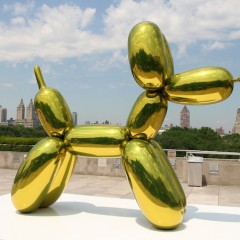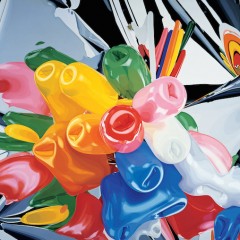[We selected some posts written by Colette Copeland’s students at the University of Pennsylvania to run in Artblog. Here they are:]
The truth, sort of
Post by Seth Manoff
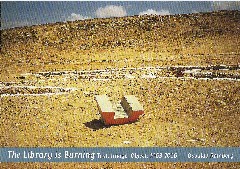
In the 1930s, Hitler burned books which he deemed subervise or which went against Nazi propaganda. Most of the world condoned this, though it was a crime against humanity.
While the days of Hitler are past, in Oswaldo Romberg’s mind, the days of distorting the facts are not. In this post-Capitalist consumer world which is in collapse, everyone is supporting the idea of relative truth through the uses of new technologies. Oswaldo Romberg deals with this gripping issue in The Library is Burning, featured at the University of Pennsylvania‘s Kamin Gallery on the first floor of Van Pelt-Dietrich Library.
The conceptual exhibit features a “series of boxes covered in texts, which are sequentially burned in a protest against historical annihilation.” He encloses many of his works; combinations of art cutouts, books, and natural elements; in resins and seals pages of books with glue in order to try and “preserve” them, as if they were fossils, or something from the past which does not exist anymore. For example, in Treasures of the Uffizi (2004); which contains wood, a monkey skull, insects, and a book also entitled Treasures of the Uffizi; is in a box and is displayed as if Romberg were trying to preserve elements of humanity from the past.
Additionally, many of his pieces have parts which are missing (carved out to make room for other objects). For example, in Dilemma Between Faith and Knowledge (1996), a major part of the Columbia encyclopedia is missing, and a bible is taking its place, illustrating how much religion is taking the place of science and fact.
Finally, it is interesting to note how some of the information in the description of the artworks is incorrect. In The Smile of David (2006), the description reads “David’s Michelangelo,” instead of Michelangelo’s David. This could have been a mistake or intentional on Romberg’s part to illustrate how certain facts are accepted as true regardless of whether or not it is actually true.
The Library is Burning: Text, Image, Object: 1963-2006, open Monday to Friday, 9 a.m. to 5 p.m., runs to June 7.
–Seth Manoff
Art history according to Jeff Koons
Post by Allan Zhang
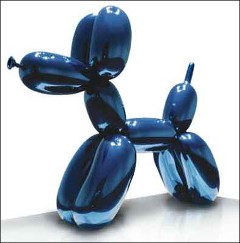
Balloon Dog by Jeff Koons
I walked out of the Jeff Koons lecture [at the University of Pennsylvania, Friday April 7] puzzled and intrigued by sexual characteristics of vacuum machines and how various positions may give them masculine/feminine qualities. I guess that was the part of the lecture that I really did not understand.
Koons presented to an audience of over 600 a retrospective of his art: from the inflatable bunnies of the 1970s to Equilibrium series (Two Ball 50/50 Tank) and Banality series of the 1980s to the giant, over-grown plant puppies and the bikini, flesh removed poster/paintings of the 1990s and beyond.
A lot of his work required the viewer to make wild and improbable connections – and not just the vacuum and sexuality thing, but also pictures of him and Cicciolina having sex (‘Made in Heaven’) as a comment on Picasso and Duchamp’s art, and the stainless buckets and trains as a commentary on differences in socio-economic classes.
A lot of the relationships that he demands of viewers are really improbable, and I suppose that is why some has criticized his art as ‘artificial’ and ‘cheap’. I don’t believe so. Although the guy has made some really crazy works, his approach to creating art is pure.
Actually, I don’t think he wanted the audience to laugh when he remarked on vacuum machine positions and sexuality – it was just his unique approach. Koons has a very unique vision on art, and I believe that alone is the quality that made him wildly successful.
–Allan Zhang
Jeff Koons’ yard sale
Post by Anastasia Kouriatova
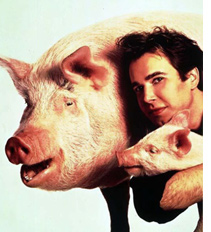
Jeff Koons and pigs in the ’80s
Thank you Jeff Koons for gracing us with your presence. We were obviously in the presence of a demi-God. We might have paid ten grand for you to actually show up and give us your power point lecture, but God knows that you were doing us a favor in showing up at all, so it was completely necessary for you to begin your lecture by forshadowing the patronizing tone you were going to use throughout your presentation.
Perhaps, on its own, your art could have managed to retain some level of aesthetic appeal and meaning, if only by its bright colors and “eye-popping” ness. But, after you name dropped every artist mentioned in 20th century art history texts as inspiration and reference to your works and attached such clear and meaningful themes to your work such as “banality” and “sexuality” to your vacuum cleaners and porcelain dolls any sort of meaning that could have been scraped out of your kitsch yard sale scrap ready-mades was completely negligible. Perhaps Michael Kimmelman described you best with the clear and simple “artificial” and “cheap.”
–Anastasia Kouriatova
Yamamoto’s essence of transience
Post by Vanna Stone
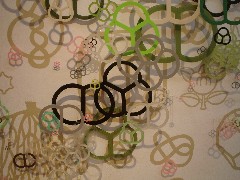
detail of Nami Yamamoto’s Stages installation at the Painted Bride Art Center
Nami Yamamoto’s symphony of vibrant shapes and silhouettes, entitled Stages, inhabits the main gallery of The Painted Bride Art Gallery until May 27.
Hundreds of colorful cut-outs made from vinyl, foam and plastic float across the walls and dance across the floor. These crisp manufactured forms are unevenly scattered across white walls dotted with unrecognizable beige figures. There is no one focus that is meant to grab attention. Instead it is the atmosphere as a whole that captures the essence of transience.
The congregation of organisms in flux lures the viewer into Yamamoto’s complex thicket of layers. These ephemeral forms weave a web primed and ready to capture the unsuspecting eye.
Yamamoto has composed a symbolic language waiting to be translated. Her simplistic, regimented forms capture the chaos of communication. The process of transcendence unfolds within these artificial forms. It is the evolutionary process that morphs beginning into end that is splattered across the gallery.
–Vanna Stone
The art of the mouse nest
Post by Elyse Lipman
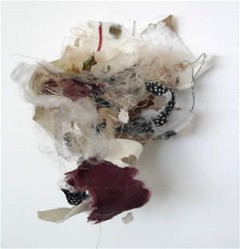
A Shirley Thomas mouse nest
I have an incredible fear of mice, of waking up to find one scurrying across my feet or across the floor. Often, these quick little animals are sly enough not to be seen. It is more common to come across one of their nests, a home they built from fluff and scraps from a room in your house.
Although I normally shudder at finding such a structure, Shirley Thomas’ exhibit “Mouse Works: The Presence of Mice” at the Third Street Gallery helps portray mice nests in a different light. Thomas manipulates various media that might be used in building a mouse nest, but displays her structures vertically on the wall of a professional gallery. By removing similar materials from the corner of an attic to an official setting, Thomas enables her viewers to appreciate the complex arrangements as art.
Thomas’ pieces range in size and materials, but all share a common theme of combining found debris into delicate, fragile sculptures. Some of her pieces, like “Old News Nest,” are much larger than any real nest; yet she continually draws attention to the process of creating structures from mixed media. By simply changing the setting and recontextualizing their site, Thomas allows the viewers to appreciate these structures for their function and composition. The exhibit is on through April 30th].
–Elyse Lipman



